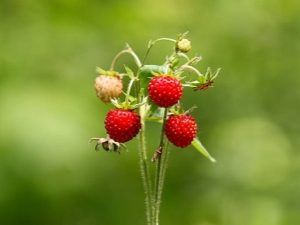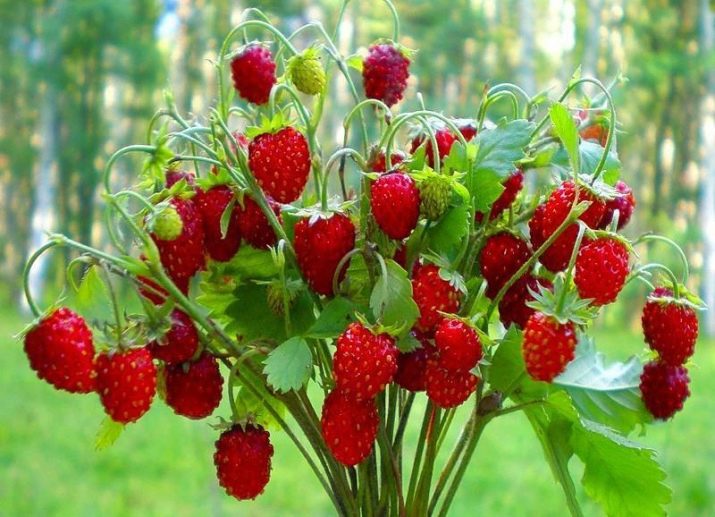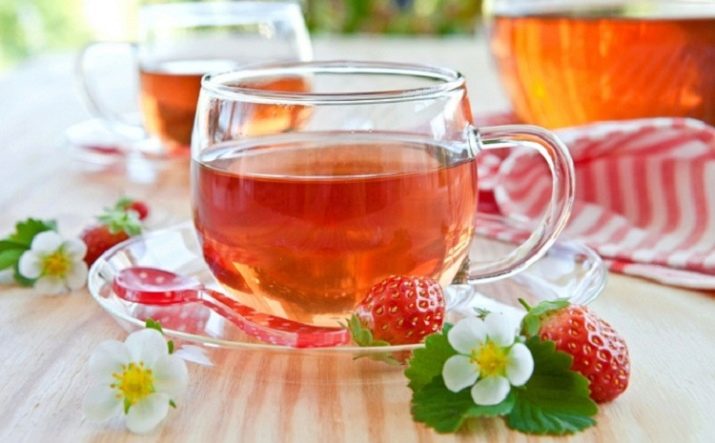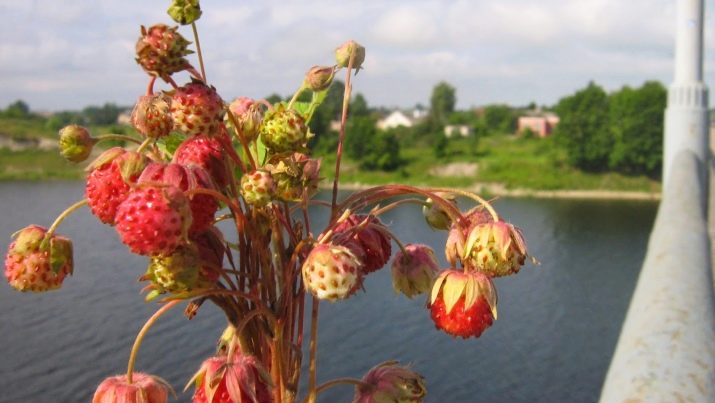When ripe strawberries?

Strawberries are a tasty and healthy wild berry that suits people with heart problems and all those who want to improve their immunity. This culture grows in forest and field conditions, therefore, to find bushes to collect fruit is not easy.
To get a tasty and healthy harvest, you should know the places for gathering, as well as the ripening period of the berries. It can vary significantly depending on the type and location of strawberries.
Special features
Small, juicy berries with lots of vitamins grow in the field and in the forest. Bushes are actively developing and fruiting, where there is a sufficient amount of sunlight. Without it, the berries will not grow and, on the contrary, if there is enough light, ripening will occur faster.
Strawberry is a whole storehouse of nutrients. The greatest number of them is contained in the fruits of culture, which are collected in the "second wave". To preserve all the useful properties of the product, it is recommended to use it rawand also to collect in accordance with certain rules, which are described below.
Important! In Samara, strawberries appear much earlier than in the Moscow region or the Moscow region.
Where to find?
Strawberries, as mentioned above, grows in unshadowed places. Of course, it can be found in the forest, but then it will be adjacent to the lighted lawn or the place where the trees fell from the wind, and a gap formed. In the forest, bushes should be sought in the following places:
- on the edge;
- in the meadows;
- in places with a large amount of deadwood;
- in clusters of shrubs;
- in young groves, where the crowns of trees still do not absorb all the sunlight.
It should be noted that the most juicy and useful berries grow where the sun is most. At the same time, excessive terrain aridity does not benefit the culture. When picking berries in a well-lit meadow, it is recommended to immediately try strawberries. It may be overdried, especially if there was a small amount of rain in the summer season.
To get the best harvest, it should be harvested in locations that combine wet, but not overmoistened soil and an abundance of sunlight.
Wild strawberries can also be found in the field, where it is usually smaller than in the forest, because the field terrain is initially less wet than the forest, but the berries ripen faster here. If you want to collect fruits with sourness, it is optimal to look for them in the field. In the field, strawberries rarely grow among the ears of rye, wheat and other cereals. Not find it on the plowed land, planted with technical crops - beets, potatoes, cabbage.
Growing strawberries requires wild conditions, unplowed land and the presence of a rather thick, but not too high, grassy environment. The optimal conditions for growing in the field are the accumulations of weeds: they protect the fruit crop from burnout, if in the summer period there is an excess of moisture, save the berries from excessive wateriness.
Gestation period
The ripening period of strawberries varies depending on factors such as:
- type of culture (wild or domesticated);
- climatic zone (midland, southern or northern);
- growing conditions (field, forest, home bed);
- additional factors (too dry or cold summer, the presence of an awning over the garden beds with culture).
Given these factors, the time of ripening and harvesting is changing.
On average, strawberries ripen in the first month of summer and can be harvested during the second half of July and all of August.
However, in some areas, the harvest season may begin in May, in others, it may begin and end in August and even September. It is worth considering in more detail several popular varieties of strawberries.
- Wild strawberry ripens a little earlier than the forest, as it is provided with a large amount of sunlight.In the middle lane you can start collecting it already from the middle of June, if the month was rather warm. However, the culture disappears early: by the middle of July, all the berries usually dry up or are harvested by collectors, and the new ones do not ripen, as there are no more ovaries.
- Forest. In the forest, strawberries ripen slower. Begin collecting in the middle lane should be closer to the end of June or in the last third. The harvest season ends at the end of July. In the forest, berries can be more watery, so you should carefully collect too large fruits: they can be soft and tasteless.
Rehabilitative strawberries
The repair strawberry is a cultivated crop that is distinguished by a longer period of fruiting and flowering as compared to wild. The domesticated bushes are slightly larger, as are the berries on them. Due to this, the taste of the remontant strawberry is less saturated, but sweeter.
Vitamins in home culture is also less, but their number still exceeds the level characteristic of strawberries. For this reason, even the use of homemade strawberries is very good for health.
If strawberries are grown under a transparent film, it can ripen at the very beginning of June. The fruits are sourish, but this is normal for the “first wave” of both wild and domesticated culture. Next, there are already sweeter and richer berries.
It is the remontant strawberries grown under the film that are most often sold at the beginning of the summer season. You can distinguish it by larger fruits and the absence of a strong aroma, which is inherent in wild berries.
The fruiting period of remontant strawberries depends on the conditions of care for it. The more mineral fertilizers, sunlight and water (but without bogging the terrain) it receives, the better the ovaries develop, which will become fruits in the future. With proper care from strawberries, you can achieve a harvest for the entire summer season and even for September, if the first month of autumn is warm.
If the gardener's goal is to get as many berries as possible, do not pick flowers and leaves for decoctions and teas. The plant may weaken, and cease to bear fruit normally.
In the southern regions and in the North
Above were given the terms of ripening culture for central Russia. However, in other regions of the country, the characteristics of strawberry fruiting differ. In the south, where warm time begins in May, the harvest can be expected at the end of spring. It lasts until the end of June, some bushes can be found in July, but with a very small probability.
In the northern regions, where both May and June are rather cold, fructification begins only at the end of July, during a warmer period. Accordingly, the berries can be harvested throughout August, and sometimes in the first two weeks of September.
Berry picking rules
Because of the small fruits, harvesting strawberries is difficult. Sometimes the process can take several days or even weeks. To shorten and simplify it, you should follow simple rules.
- Berry should be collected only in clean areas, where there is no pollution from the road or swamp. Some forests are filled with household and plastic waste. In such places, the harvest is also not worth it, because it can lead to poisoning.
- Before picking a berry on the field, you should make sure that it is not processed for agricultural purposes. If the field or its part is used as a location for the mass cultivation of various crops, then the berries and leaves of the strawberries most likely contain a large amount of pesticides. They are dangerous to health, especially if the child will consume the berries.
- Attention should be paid to where the culture took moisture during maturation. If a streamlet or a river is located nearby, you need to make sure that they are fairly clean. Contaminated water, from which plants feed, is one of the most frequent causes of food poisoning when eating fruits of a forest culture.
How to extend the shelf life of the crop?
There is an opinion that berries should be picked only early in the morning, “according to the dew”. Then the fruits will be stored for a long time, not to change while carrying. However, in fact, morning dew, which is a standard condensate, can lead to accelerated rotting of the berry, if not dried.
Therefore it is recommended not to go to the forest or field very early in the morning. It is better to wait until the moisture from the fruits and leaves disappear.
You can not harvest in the rain, because the abundance of moisture will lead to rapid decay of the product. In addition, he will be heavily creased in the basket or bucket and is unlikely to reach the table in a suitable form. Large, too watery berries are not recommended for the same reason. Being too soft, they can easily turn into a mush, as well as dirty other berries.
It is better to put the berries in the basket, since there are holes in it for the removal of moisture. Even slightly wet fruits will dry out a bit if you put the basket in the purged place.
If the harvested crop is seriously wet, you should pull it out of the container and spread it out on a kitchen towel to dry the berries.
How to shoot berries?
Because exactly how the berries will be removed from the stem, depends on their storage, as well as the integrity of the strawberry bush. The last factor is important, even if the bush is wild and is not located on the site. "Wicks" can still produce a crop during the ripening period, if their stalks are not damaged, therefore it is necessary to treat them carefully. The same rule applies to remans strawberries. When picking fruits, it is recommended to use small scissors and cut the stalk close to the berry itself.
If the berry is separated from the stem, leaving it on the stem, the juice can quickly flow out of the fruit, it can be deformed during transport and storage. Often, the berry is damaged just at the moment when they are trying to remove it from the stalk.
On the cultivation of strawberries on the balcony described in the next video.































